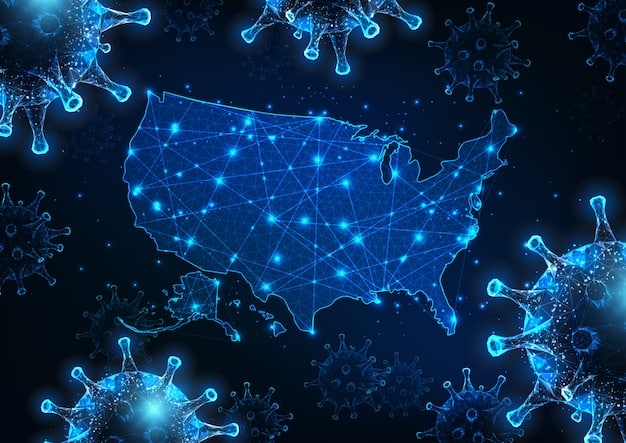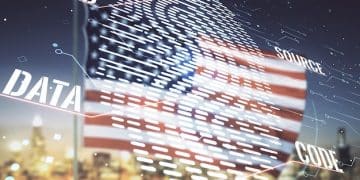Quantum Computing Impact on US Data Security by 2025

By 2025, quantum computing is expected to significantly challenge existing encryption standards, necessitating urgent upgrades in US data security infrastructure to mitigate unprecedented cyber threats.
In the rapidly evolving landscape of technology, the question of how will quantum computing impact US data security by 2025 looms large, transforming from a theoretical future concern into an urgent, near-term challenge. This imminent shift demands a closer look at the potential disruptions and the proactive measures required to safeguard critical national assets.
the quantum threat: understanding post-quantum cryptography
The advent of quantum computing promises computational power far exceeding that of classical supercomputers. While this opens doors for breakthroughs in medicine, materials science, and artificial intelligence, it also poses a significant threat to current cryptographic standards. The mathematical problems that underpin modern encryption, such as RSA and ECC, are vulnerable to quantum algorithms.
This vulnerability creates what is known as the “Quantum Challenge.” The concern isn’t just about breaking current encryption; it’s about the ability of a sufficiently powerful quantum computer to retroactively decrypt vast amounts of previously recorded, encrypted data. This makes the transition to new, quantum-resistant encryption crucial.
the rise of shor’s algorithm
One of the most concerning quantum algorithms is Shor’s algorithm, capable of efficiently factoring large numbers and solving discrete logarithm problems. These are the very mathematical foundations upon which widely used public-key cryptographic systems like RSA and ECC rely. A functioning quantum computer running Shor’s algorithm could:
- 🔓 Decrypt encrypted communications.
- 🔑 Forge digital signatures.
- 🛡️ Compromise secure online transactions.
The time horizon for a quantum computer capable of executing Shor’s algorithm and breaking current encryption is a subject of ongoing debate among experts. While some predict it within the next decade, others suggest it could be sooner, making the 2025 timeframe a critical window for preparedness.
lattice-based cryptography and other solutions
Recognizing the impending threat, cryptographers worldwide are developing and standardizing “post-quantum cryptography” (PQC) algorithms. These new algorithms are designed to be resistant to attacks from both classical and quantum computers. Leading candidates for PQC:
- Lattice-Based Cryptography: Based on the hardness of certain problems in complex mathematical structures called lattices, offering strong resistance to known quantum attacks.
- Code-Based Cryptography: Relies on error-correcting codes, providing another robust approach.
- Hash-Based Signatures: Offers secure digital signatures, though often with larger key sizes.
The National Institute of Standards and Technology (NIST) has been at the forefront of this effort, running a multi-year competition to select and standardize a suite of PQC algorithms. This standardization process is crucial for ensuring interoperability and widespread adoption across the globe.
The urgency stems from the “harvest now, decrypt later” threat. State-sponsored actors or advanced persistent threats could collect encrypted data today, store it, and decrypt it once a sufficiently powerful quantum computer becomes available. This makes the migration to PQC not just a matter of future security but also a defense against past and present data compromises.
us government and industry response: a race against time
The US government has recognized the quantum computing threat as a matter of national security. Agencies like the National Security Agency (NSA) and NIST have been instrumental in pushing for PQC development and adoption. The goal is to facilitate a smooth, secure transition to quantum-resistant encryption across all critical infrastructure.
This includes federal agencies, defense contractors, financial institutions, and essential services. The challenge lies not only in developing the new algorithms but also in deploying them across vast and complex IT ecosystems. Retrofitting existing systems can be costly and time-consuming.

nist’s standardization efforts
NIST’s Post-Quantum Cryptography Standardization Project is perhaps the most significant effort globally. Since 2016, NIST has been evaluating various PQC algorithms submitted by researchers worldwide. The process involves rigorous analysis of security, performance, and implementation characteristics. By 2025, several of these algorithms are expected to be fully standardized, providing clear guidelines for deployment.
The standardization timeline dictates that by 2025, organizations will have a clearer roadmap for which PQC algorithms to implement. However, actual large-scale implementation will take significant time and resources, underscoring the urgency of starting preparation now.
executive orders and legislative initiatives
The US government has issued executive orders and introduced legislation aimed at accelerating the transition to quantum-resistant cryptography. These mandates emphasize the need for federal agencies to identify vulnerable systems, plan for upgrades, and engage with the private sector to foster innovation and adoption.
Key legislative actions:
- Quantum Computing Cybersecurity Preparedness Act: Requires federal agencies to inventory cryptographic systems that could be vulnerable to quantum computing and to prioritize transitioning them to PQC.
- National Quantum Initiative Act: Supports research and development in quantum information science, including quantum computing and cryptography.
These initiatives are designed to ensure a coordinated national response to the quantum threat. However, legislative action alone isn’t enough; extensive collaboration between government, industry, and academia is vital for successful implementation.
Industry players, particularly in the tech, finance, and defense sectors, are also investing heavily in quantum-safe solutions. Companies are conducting risk assessments, developing PQC-compatible products, and educating their workforce on the impending changes. The synergy between government directives and private sector innovation will be critical in securing US data by 2025.
vulnerable sectors and the cost of inaction
The impact of quantum computing on data security by 2025 will not be uniform. Certain sectors, due to the nature and longevity of their data, are particularly vulnerable. These include:
- Government and Defense: Classified information, intelligence data, military communications, and critical infrastructure control systems.
- Financial Services: Banking transactions, stock market data, customer financial records, and secure payment systems.
- Healthcare: Patient records, medical research data, and sensitive health information.
- Energy Grid and Utilities: Operational technology (OT) systems, smart grid data, and energy supply chain communications.
- Communications and IT: Internet infrastructure, VPNs, encrypted messaging, and cloud services.
The data in these sectors often has a very long shelf life, meaning that information encrypted today could still be valuable decades from now, when a quantum computer might be able to decrypt it. This “long-term secrecy” problem is a prime motivator for immediate action.
the economic and reputational costs
The economic cost of inaction could be staggering. A successful quantum attack on critical infrastructure or financial systems could lead to:
- Financial instability due to compromised transactions and stolen funds.
- Widespread data breaches, resulting in massive fines and loss of consumer trust.
- Disruption of essential services, including power grids, water supply, and transportation networks.
Beyond the financial implications, there are significant reputational costs. Companies and government agencies that fail to adequately protect sensitive data against quantum threats risk losing credibility and public confidence. National security could be severely compromised if adversaries gain access to classified information or the ability to disrupt vital systems.
Consider the potential for supply chain attacks. If a critical component in a widely used piece of hardware or software is compromised quantumly, the ripple effect could be devastating. This highlights the need for a holistic approach to PQC migration that extends beyond an organization’s immediate perimeter to its entire supply chain.
Security practitioners estimate that a full “crypto-agile” transition—where systems can easily switch between cryptographic algorithms—could take years, if not decades. This underlines why 2025 is a crucial turning point, pressing organizations to move from assessment to active implementation. The longer the delay, the greater the risk, and the higher the eventual cost of remediation.
challenges in transition: technical and logistical hurdles
Transitioning to post-quantum cryptography is not a simple “plug and play” operation; it involves significant technical and logistical challenges. One of the primary hurdles is the “crypto-agile” dilemma. Many existing systems are not designed to easily swap out cryptographic algorithms, often embedding them deep within hardware or proprietary software.
Updating these systems can require substantial re-engineering, testing, and deployment. The sheer scale of systems that rely on vulnerable cryptography, from internet protocols to smart cards, makes this a monumental undertaking. Furthermore, the performance characteristics of PQC algorithms—such as larger key sizes and potentially slower operations—must be carefully managed to avoid degrading system performance.
compatibility and interoperability
Ensuring compatibility and interoperability across diverse systems and platforms is another major challenge. As different sectors and countries migrate to PQC, there is a risk of fragmentation if not everyone adopts the same standards or if implementations differ. This could create new security gaps or break existing secure communication channels.
For example, if one part of a critical infrastructure system updates to PQC while another component does not, a weak link remains. This demands a coordinated effort across all stakeholders, from hardware manufacturers to software developers and service providers, to ensure a seamless transition without creating new vulnerabilities.
workforce and expertise gaps
The specialized knowledge required for quantum cryptography and its implementation is scarce. There is a global shortage of cybersecurity professionals with expertise in quantum mechanics, advanced mathematics, and cryptography. Training and upskilling the existing workforce, as well as attracting new talent, are essential to meet the demands of this transition.
Without sufficient expertise, organizations may struggle to:
- Assess their current cryptographic posture.
- Identify all vulnerable systems.
- Properly implement and test new PQC solutions.
- Respond to quantum-related incidents.
Universities and research institutions are playing a crucial role in developing the next generation of quantum-savvy professionals. However, the pace of education and talent development needs to accelerate to match the timeline of the quantum threat. By 2025, the gap in skilled professionals could become a significant bottleneck for PQC adoption.
In addition, the complexities of integrating PQC into legacy systems mean that organizations cannot wait for a perfect solution. They must begin assessing their “cryptographic inventory” now, identifying which assets are most vulnerable and prioritizing their migration. This iterative approach, starting with the highest-risk data, will be crucial for managing the transition effectively amidst these significant challenges.
strategic imperatives for us data security by 2025
To effectively address the quantum computing threat by 2025, the US data security landscape requires a multi-pronged strategic approach. This involves not only technological upgrades but also policy modifications, increased collaboration, and sustained investment. A key imperative is immediate cryptographic inventory and risk assessment.
Organizations must identify all cryptographic assets, their current algorithms, and the sensitivity and lifespan of the data they protect. This comprehensive understanding is the foundation for prioritizing PQC migration efforts. Without a clear picture of what needs securing and when, efforts can be scattered and ineffective.

accelerated pqc adoption and deployment
The pace of PQC adoption must accelerate across both government and private sectors. This means:
- Early Pilots: Implementing PQC in pilot programs on non-critical systems to test compatibility, performance, and identify potential issues before widespread deployment.
- Vendor Collaboration: Working closely with technology vendors to ensure PQC-compatible products and services are readily available.
- Update Roadmaps: Developing clear, actionable roadmaps for transitioning critical systems to quantum-resistant encryption, integrated into broader cybersecurity strategies.
By 2025, the goal should be to have a significant portion of critical infrastructure and high-value data protected by PQC systems, or at least to have clear plans and initial implementation underway. This proactive stance is essential given the potential speed of quantum advancements.
enhanced funding and research
Sustained and increased funding for quantum information science, including quantum cryptography research and development, is paramount. This investment should support:
- Basic research into new quantum-safe algorithms.
- Development of quantum-resistant hardware and software.
- Creation of testing and validation environments for PQC solutions.
- Talent development programs to build a skilled workforce.
Public-private partnerships can play a crucial role in pooling resources and expertise, accelerating the pace of innovation. The competitive nature of quantum technology development globally means that the US must maintain a leadership position through continuous investment.
international cooperation and standardization
Given the global nature of data and cyber threats, international cooperation is vital. The US should continue to collaborate with allies and international bodies to align on PQC standards, share best practices, and collectively address the quantum threat. This ensures interoperability and strengthens collective cybersecurity defense.
By 2025, a robust international framework for PQC adoption would significantly enhance global data security. This includes:
- Sharing threat intelligence on quantum developments.
- Harmonizing PQC deployment guidelines.
- Jointly developing secure supply chains for quantum-safe components.
These strategic imperatives are not merely recommendations; they represent urgent necessary actions. The window of opportunity to prepare for quantum impact on US data security by 2025 is rapidly closing. Proactive and coordinated efforts will determine the nation’s resilience in the face of this unprecedented technological shift.
the human element: building a quantum-aware workforce
Beyond the technical complexities of quantum computing and post-quantum cryptography, the human element stands as a critical factor in securing US data by 2025. A quantum-aware workforce is not just about a few highly specialized cryptographers, but rather a broader understanding across various levels of an organization.
This includes IT professionals, cybersecurity analysts, software developers, and even executives. Lack of awareness and insufficient training can severely impede the successful implementation and management of PQC solutions. Organizations need to invest in comprehensive education programs to bridge this knowledge gap.
raising awareness and education
The first step is to raise awareness about the quantum threat and the importance of PQC among all relevant stakeholders. This involves:
- Leadership briefings: Educating senior management on the strategic implications and necessary investments.
- Technical workshops: Providing hands-on training for engineers and developers on PQC algorithms and their integration.
- Cybersecurity training: Incorporating quantum considerations into general cybersecurity awareness programs for all employees.
By 2025, a basic understanding of quantum implications should be part of the standard curriculum for cybersecurity professionals in the US. This ensures that new talent entering the workforce already possesses foundational knowledge, reducing the need for extensive retraining.
developing specialized skills
For those directly involved in cryptographic systems, specialized training is indispensable. This includes:
- Cryptography experts: Deep dives into the mathematics and security proofs of PQC algorithms.
- Software architects: Guidance on designing crypto-agile systems that can seamlessly switch between algorithms.
- System administrators: Training on deploying, configuring, and managing PQC-enabled infrastructure.
Universities and vocational training centers should consider new curricula and certifications focused on post-quantum security. The demand for these skills will only grow, and addressing this demand proactively is vital. Building a pipeline of quantum-literate professionals will be a long-term endeavor but essential to sustaining secure operations.
Furthermore, the human element extends to decision-making. Informed decisions about where to invest, when to migrate, and what risks to accept can only be made by a leadership team that fully comprehends the quantum challenge. By 2025, the US needs a cadre of leaders across critical sectors who are fluent in the language of quantum security.
Ultimately, the success of US data security against quantum threats hinges on human ingenuity, adaptability, and collective effort. Investing in the workforce today ensures that the nation is not only technologically prepared but also intellectually capable of safeguarding its digital future.
prediction and outlook: beyond 2025
While 2025 serves as a critical near-term milestone for US data security in the face of quantum computing, the journey does not end there. By 2025, we anticipate significant strides in PQC standardization and initial deployments, transforming from theoretical concerns to practical implementation phases. However, the quantum threat landscape will continue to evolve.
It’s crucial to understand that quantum computing itself is still in its early stages. While prototypes exist, large-scale, fault-tolerant quantum computers capable of breaking current encryption are not yet readily available. The 2025 timeframe is largely about preparing for that inevitability rather than actively defending against immediate quantum decryption attacks.
the quantum-safe transition period
Beyond 2025, the US will enter a protracted “quantum-safe transition” period. This phase will involve the methodical replacement of
vulnerable cryptographic systems across all sectors. This won’t be a single event but a multi-year effort, potentially extending into the 2030s, as different systems are updated, tested, and deployed.
During this period, organizations will likely adopt “hybrid” cryptography, using both current classical algorithms and new PQC algorithms simultaneously. This approach provides a fail-safe, ensuring security even if vulnerabilities are later found in the initial PQC standards or if quantum breakthroughs happen faster than expected.
continuous evolution of quantum technology
The field of quantum computing is dynamic. Breakthroughs in qubit stability, quantum error correction, and new quantum algorithms could accelerate the development of powerful machines. This means that data security strategies must remain agile and adaptable, continuously monitoring quantum progress and adjusting PQC implementations as needed.
The US must therefore foster an ecosystem of continuous research and development in quantum-resistant technologies. This goes beyond just cryptography to include quantum-safe communication networks (e.g., quantum key distribution) and quantum-hardened hardware. The goal is to build a resilient and enduring security posture, not just a temporary fix.
By 2025, the groundwork for a quantum-resilient US data security infrastructure should be firmly laid, characterized by active PQC deployments in critical areas and a strong national strategy for ongoing adaptation. The challenge is immense, but the commitment to safeguarding national data and critical infrastructure from the quantum future is unwavering, ensuring that beyond 2025, the nation remains secure in the quantum age.
| Key Aspect | Brief Impact by 2025 |
|---|---|
| ⚛️ Quantum Threat Emergence | Shor’s algorithm will pose a clear, theoretical risk to current encryption by 2025, driving urgent PQC adoption. |
| 📜 NIST Standardization | NIST PQC standards will be largely finalized, providing a crucial roadmap for quantum-safe transitions. |
| 🚧 Transition Challenges | Significant technical hurdles in PQC implementation, workforce shortages, and system retrofits will be evident. |
| 🛡️ US Preparedness | Increased government/industry collaboration and initial PQC pilots will strengthen US data security posture. |
frequently asked questions on quantum computing and us data security
The primary threat from quantum computing to existing data security lies in its ability to break current public-key encryption standards like RSA and ECC. Algorithms like Shor’s can efficiently factor large numbers, which are the mathematical basis for these widely used systems, thereby compromising sensitive encrypted data and communications.
No, it’s highly unlikely that quantum computers will be able to decrypt all data by 2025. While prototypes exist, large-scale, fault-tolerant quantum computers capable of breaking current encryption are not expected to be publicly available within that timeframe. The focus by 2025 is on preparing for this future threat through post-quantum cryptography development.
Post-quantum cryptography (PQC) refers to new cryptographic algorithms designed to be secure against attacks from both classical and quantum computers. These algorithms are based on different mathematical problems that are thought to be difficult even for quantum computers, such as those involving lattices, codes, or hashes.
The US government is preparing through several key initiatives. The National Institute of Standards and Technology (NIST) is leading the standardization of post-quantum cryptography. Additionally, legislative actions like the Quantum Computing Cybersecurity Preparedness Act mandate federal agencies to identify and transition vulnerable systems, fostering a coordinated national response.
The “harvest now, decrypt later” threat describes a scenario where malicious actors, particularly state-sponsored ones, collect and store encrypted data today. Their intention is to decrypt this sensitive information in the future, once a sufficiently powerful quantum computer becomes available. This makes proactive PQC adoption critical for long-term data secrecy.
conclusion
The question of how quantum computing will impact US data security by 2025 is not one of if, but of how profoundly and how swiftly the preparations can mitigate its effects. By 2025, the US will be deep into a proactive phase, with critical PQC standards finalized and initial deployments underway across vulnerable sectors. The ongoing challenges of technical integration, workforce development, and maintaining cryptographic agility will define the success of this transition. While a full conversion to quantum-safe systems will extend beyond this immediate horizon, the groundwork laid by 2025 is essential for safeguarding national security and economic stability in the emerging quantum era.





